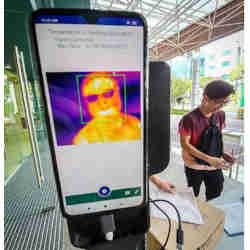
It's no secret that hospitals are at the epicenter of the COVID-19 crisis. Every day, highly infectious patients stream into medical facilities and threaten to infect healthcare workers and other patients. Healthcare experts and hospitals are fighting back by turning to artificial intelligence (AI) and the Internet of Things (IoT) to aid in the battle.
"AI can help in various ways," observes Eyal Zimlichman, deputy general director, chief medical officer, and chief innovation officer at Sheba Medical Center in Tel Hashomer, Israel. "AI tools will help us gain quicker insights into treatment protocols, patient assessment, and prediction of changes in clinical situation. Furthermore, AI can help gain insights on an epidemiological level."
Chakri Toleti, founder and CEO of care.ai, an Orlando, FL, company that has developed an AI platform for hospitals, says the technology can reduce risk for staff and the public. "AI-powered thermal entry sensors automate temperature screenings of people entering a healthcare facility. It identifies persons with a fever."
AI is the New Medicine
Hospitals and healthcare experts on the front lines of the COVID-19 pandemic increasingly are turning to machine learning, deep learning, and other AI methods to identify patterns, trends, and risks—and take steps to battle the virus. "Information regarding patient movement in the community might allow us to predict outbreaks locally and adjust policy accordingly," Zimlichman says.
For example, the Seattle, WA-based Allen Institute for Artificial Intelligence (AI2) has developed the Semantic Scholar Project, which uses natural language processing to sort through social media data and scholarly papers in order to spot patterns that might escape human detection. Others are looking to tap smartphone location data to gain insights.
At hospitals, AI is helping staff make more informed decisions. AI can generate prediction models that show the most effective clinical pathways for highly acute conditions, such as coronavirus. "This will help us better utilize resources, such as ICU beds and ventilators, as well as improve patient outcomes," Zimlichman says.
Medical facilities are also putting AI to work in other, often more direct, ways. At Tampa General Hospital in Florida, for example, anyone entering one of the facility's six entrances is screened using an AI-based temperature detection solution that incorporates image scanning and thermal inferencing. The solution recognizes behavioral patterns and identifies people with a fever; medical staff can then intervene immediately.
The system, developed by care.ai, reduces the need for manual screening, freeing up medical staff to spend more time tending to critical functions of triage and care delivery, Toleti says. The care.ai platform uses a sensor-fusion stack that runs specialized AI algorithms and neural networks. Once it detects abnormal readings, it sends notifications to care team members so an appropriate intervention can occur.
Playing It Safe
Another facility on the front lines of AI is Sheba Medical Center. It has incorporated several IoT and AI functions to aid in decision-making, patient quality, and overall safety. For example, "With the COVID-19 pandemic, we are using AI-based monitors that continuously track our COVID-19 patients and use AI-based alerts to predict imminent clinical deterioration," Zimlichman says.
The hospital uses a system from Woburn, MA-based EarlySense Ltd. that relies on sensors, including one in a patient's mattress, to identify possible patient problems in its 40-bed intensive care unit (ICU). Software applies machine learning to filter data and determine when a patient is likely to experience respiratory failure or sepsis within the next six to eight hours. The facility also uses an AI-powered control tower from CLEW Medical to better manage the ICU.
As medical experts take aim at COVID-19, other AI-based technologies are emerging. Rob Mesirow, U.S. Connected Solutions/IoT Practice leader at business and technology consulting firm PwC, says image recognition used with AI can aid in hand-washing or scrubbing and other critical tasks, though medical facilities, restaurants, and others that use this technology must be aware of privacy concerns. "The right systems can dramatically improve behavior and compliance," he says.
Despite remarkable advances in AI—and the potential benefits for battling a pandemic such as COVID-19—not everyone is entirely sold on the concept. Some experts argue that the technology is relatively new, and not all AI systems are ready for primetime use. For instance, some argue that thermal detection systems aren't accurate and dependable.
Nevertheless, Zimlichman believes that AI, along with the IoT and other digital technologies, will revolutionize medical care and the battle against COVID-19. "AI in the next few years will provide decision support to clinicians, allowing improved decision-making that would lead to better quality and patient safety, as well as more efficient care. Hospitals have much to gain from AI as they treat the most complicated and expensive cases, as well as those that pose higher patient safety risk."
Samuel Greengard is an author and journalist based in West Linn, OR, USA.



Join the Discussion (0)
Become a Member or Sign In to Post a Comment